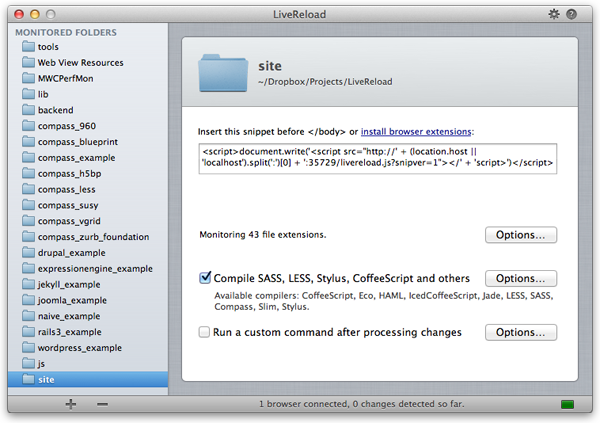简介
LiveReload会监视指定目录下的文件变更,只要文件有变更保存,LiveReload就会执行指定的命令(比如是make,build之类的操作)。同时,LiveReload包含了一个静态服务器,默认访问 http://localhost:5500 即可查看。
完整的文档可参考ReadTheDocs,这里只做Python库的简单介绍。
这里举例谈一个应用场景,是我在编写sphinx文档时遇到的:编辑sphinx文档时,总希望能够及时在浏览器中看到编辑后的页面效果,但是从rst文件转html文件,需要执行make html命令。频繁的操作很琐碎,因此需要LiveReload来替代这项工作。当工作目录中的rst文件发生变化,自动帮我执行make html命令。
示例如下(假设工作目录命名为docs/):
#!/usr/bin/env python |
server.watch 监视了docs/目录下的所有rst文件,每当文件有变更,在cwd='docs'指定的目录中,执行shell('make html')中指定的命令。
运行上述脚本,打开浏览器访问 http://localhost:5500 ,就可以实时查看到文档变更。
安装
pip install livereload
示例
命令行工具
Python-LiveReload 提供了一个命令行工具: livereload,提供了类似上述脚本的功能,但默认启动35729端口。
livereload --help |
Server(wsgi-app)
Python-LiveReload是为web开发者设计的,支持接入wsgi application.
from livereload import Server, shell |
server.watch
server.watch 可以监视具体的文件路径,或者目录,或者glob pattern:
server.watch('path/to/file.txt') |
你也可以使用其他的库(比如formic) 来提供更强大的功能:
for filepath in formic.FileSet(include="**.css"): |
server.watch还支持一个delay参数,单位为秒,表示文件变更后延迟多久才发送reload信号:
# delay 2 seconds for reloading |
server.serve
server.serve 用于启动服务器,下面是该方法的调用示例:
# use default settings |
shell
使用shel函数,可以帮你执行一些shell命令,配合server.watch一起使用:
# you can redirect command output to a file |
框架集成
Python-LiveReload支持与其他的web框架无缝对接,如Django、Flask、Bottle等,不过这些框架往往自带了类似LiveReload的功能,权当了解即可。
以Flask为例:
# app is a Flask object |
More
文档与更多示例参考:
其他扩展
sphinx-autobuild
本文开始的例子中,我提到了编辑sphinx文档时遇到的麻烦,后来发现有现成的解决方案:sphinx-autobuild
你只需要安装sphinx-autobuild:
pip install sphinx-autobuild
在工作目录docs/外运行:
sphinx-autobuild docs docs/_build/html
之后打开浏览器访问: http://localhost:8000/
商业的LiveReload
这是一家公司的商业化产品,并且进行了开源,与本文介绍的Python-LiveReload并无关系。
可以在其官网上下载到。它提供了更加便捷的功能,有兴趣可以了解下。
